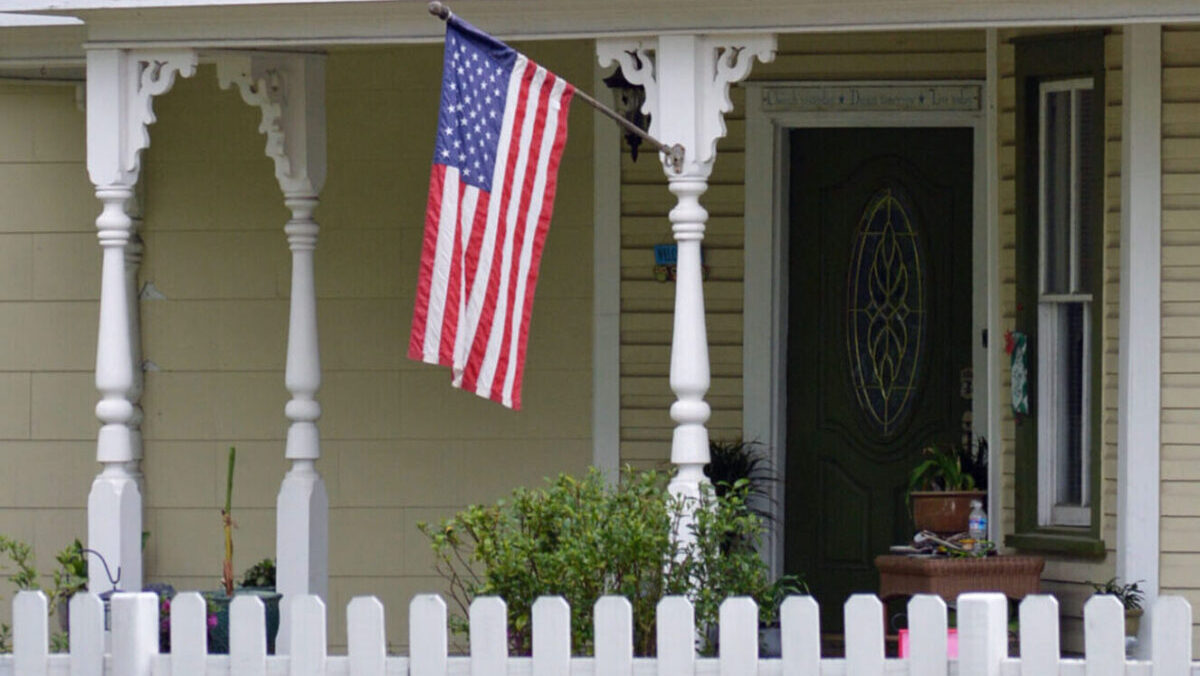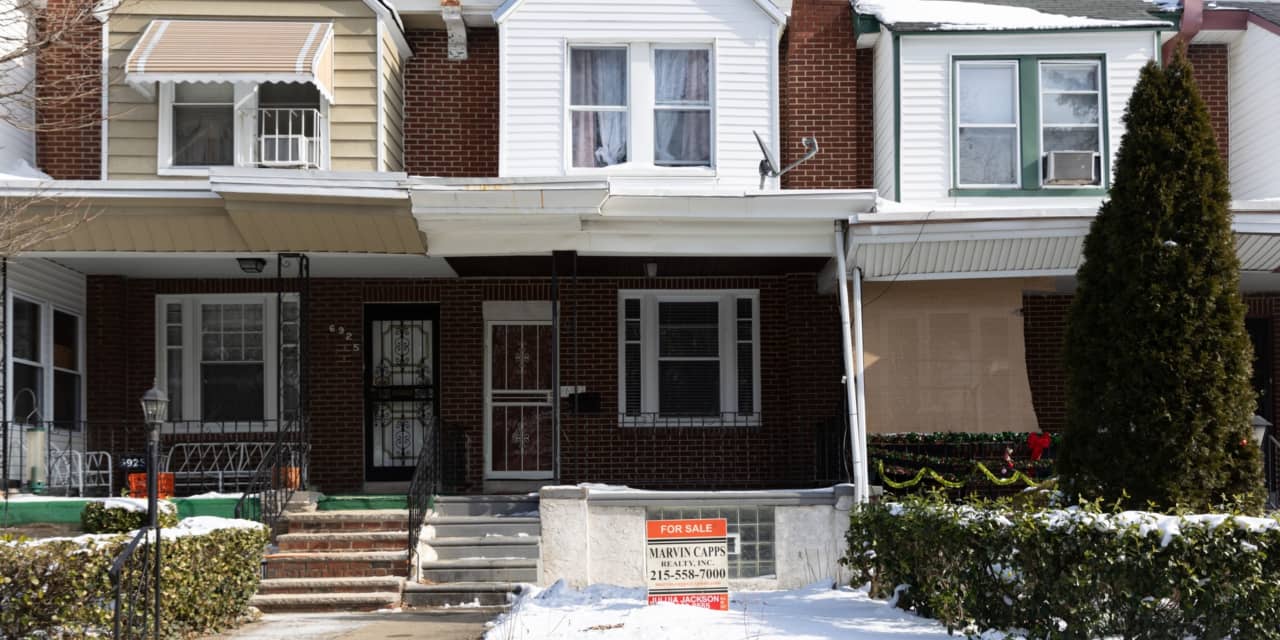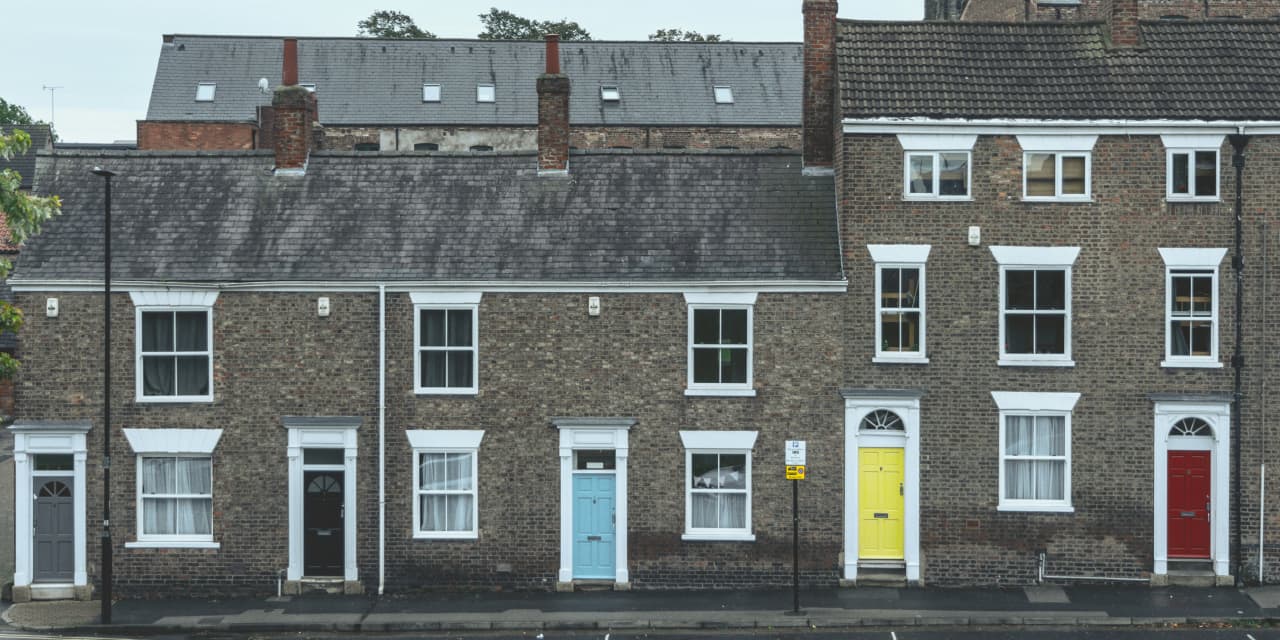Homeownership has long been a critical component of the American Dream. But under Bidenomics, owning a home is beyond the reach of many Americans due to the rising cost of owning and maintaining a home, according to the latest report by The Wall Street Journal.
Buying a home is more than having a roof over one’s head. Homeownership is the primary driver that has helped generations of Americans build wealth. A home is an appreciable asset, and its value usually increases substantially over a long period of time. Naturally, the primary residence represents the most significant asset among American households. According to the Census Bureau, homeowners’ median net worth is 80 times larger than renters’ median net worth.
However, owning a home has become very expensive under President Joe Biden. His excessive spending caused record-high inflation. The Federal Reserve had to hike interest rates dramatically between 2022 and 2023, seeking to bring inflation rates down. Consequently, mortgage interest rates spiked from around 3 percent in 2020 to over 7 percent.
Every percentage point increase in the mortgage rate means buyers must pay hundreds and thousands more for the same home or get less home for their money. According to Bankrate.com, the rising mortgage rates mean that as of July 2023, “homebuyers on a $3,000 monthly mortgage payment budget have lost $30,000 in purchasing power since February 2023 alone. In other words, they can afford to purchase a $450,000 home in July, compared to one priced at $480,000 five months ago and at $510,000 one a year ago.”
The Wall Street Journal finds that “homeownership affordability fell to its lowest level since the 1980s as mortgage rates reached a 23-year high and home prices set new records.” Consequently, more and more Americans have given up saving for a house down payment and been forced to miss out on the lifestyle they had hoped for. A Bankrate.com survey revealed that 1 in 4 Americans said the lack of housing affordability and having to rent (rather than own) makes them feel financially insecure.
Many Increased Costs
Unfortunately, the rising mortgage rate is not the only hurdle for homeownership. Many American homeowners who were able to lock in lower mortgage rates before Biden came into office are struggling to keep their homes because other costs associated with homeownership, such as property taxes, homeowner’s insurance, and maintenance and repairs, have spiked too. The Wall Street Journal reports that “property taxes, which are rising due to the effect of inflation on local government budgets, are also pushing homeowners to dig deeper into their bank accounts. … In Charlotte, N.C., the average property tax rose 31.5% from 2022 to 2023. In Indianapolis, it was up nearly 19%.”
Insurance companies cited record-high inflation as one of the reasons for soaring homeowner insurance premiums. The Journal finds that “the average annual home insurance cost rose about 20% between 2021 and 2023 to $2,377,” and nearly “10 percent of homeowners were worried that they couldn’t afford their home insurance premiums at their next renewal.” In my home state of Colorado, the average homeowner premium was up nearly 52 percent between January 2019 and October 2022. Some homeowners in Louisville, Colorado, saw their insurance premiums skyrocketed 700 percent.
In addition, the regular upkeep cost of a home, including gutter cleaning and lawn care, costs on average about $6,700 a year, representing an increase of more than 8 percent from a year earlier. About 20 percent of homeowners declared that “they couldn’t afford a $500 emergency repair without going into credit-card debt.”
A combination of higher property taxes and rising home insurance and maintenance costs has forced some homeowners to sell because they simply couldn’t afford it anymore.
Outlook
Aspiring and existing homeowners won’t see any financial relief soon since the most recent inflation report shows that the inflation rate in March rose by 3.5 percent. The stubbornly high inflation suggests that the Federal Reserve will not cut interest rates soon. If Biden wins his reelection or another Democrat becomes the president of the United States, the declining homeownership in America will likely continue.
Economically, the Democrats’ economic policies can be summarized as one word, “spending,” even though excessive spending is the root cause of high inflation. High inflation means higher interest rates are here to stay. Ideologically, a society with fewer or even no property owners is what the left aims for. The World Economic Forum bragged that if the global elites succeed in their Agenda 2030, “You will own nothing and be happy.”
American voters must wise up. Fewer Americans owning homes means fewer will be able to realize their American dreams and build long-lasting wealth; more people will have to depend on government handouts to survive. President Calvin Coolidge reminded us, “Ultimately, property and personal rights are the same thing.” The policies that destroy property ownership will also take away individual freedom. Owning nothing will only make you miserable and unfree. If you want to pursue happiness, own as much as you can and vote those anti-property-rights politicians out of office.
Home prices in New Hampshire soared to their highest on record in March, straining the ability of first-time home buyers to afford to purchase a home and pointing to a crisis in the housing market for average Americans looking to make the plunge to homeownership.
The median sale price of a single-family home rose nearly 12 percent last month to $500,000 compared to a year ago, according to the New Hampshire Association of Realtors (NHAR), the highest level yet in the state’s history. The jump in prices is hurting affordability, which declined by 16 percent from last year.
Realtors in the state say that the lack of enough supply of houses is helping to push up prices.
Read more: Compare Top Mortgage Lenders
“The problem remains the shortage of available housing that is continuing to make homeownership more difficult than ever for those workers needed to help an economy thrive,” Joanie McIntire, president of New Hampshire Association of Realtors, said in a statement.
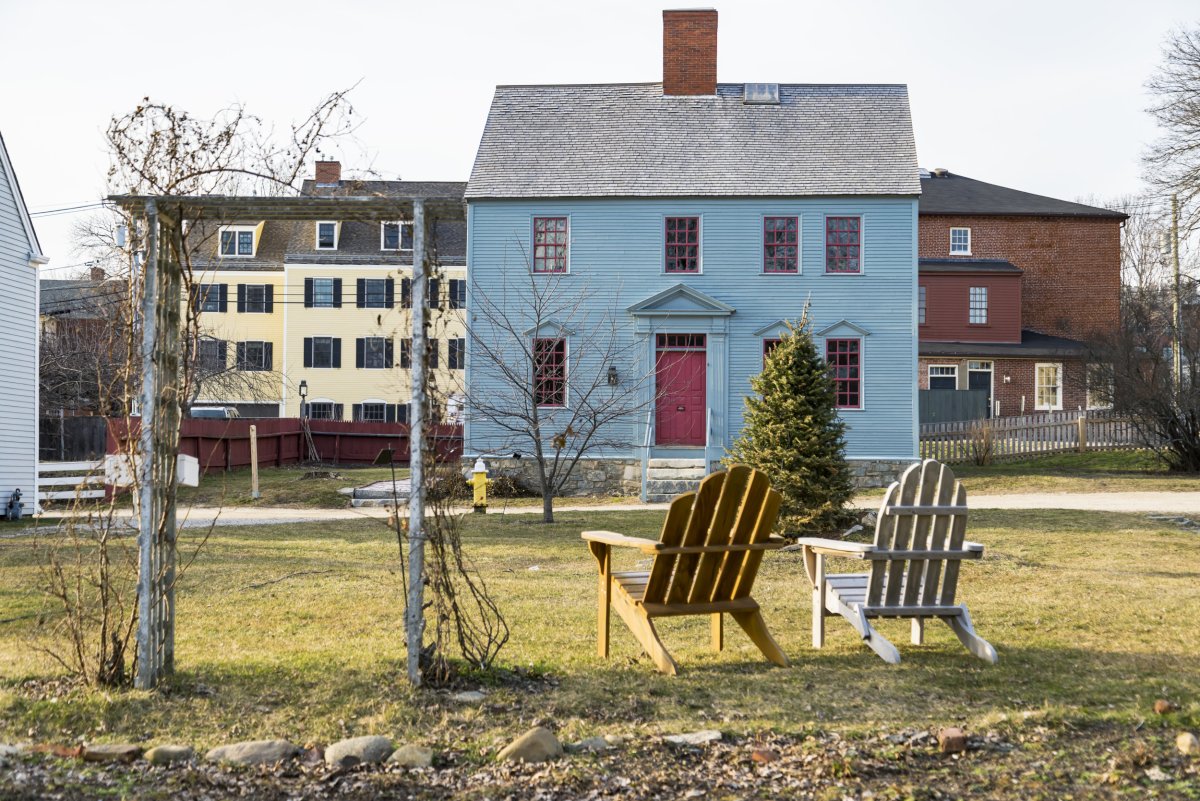
Stock Photo/Photo Italia LLS via Getty Images
The state’s realtors point out that its affordability index dropped to 59 last month. This suggests that residents in the state are earning 59 percent of the amount needed to be able to afford to purchase a house, the lowest reading since 2005.
The association said depleted inventory is the main reason why house prices in the state are so elevated. Single-family homes available for sale dropped by 2 percent from a year ago to about 1,230 homes, a 1.3 month of supply. A healthy market needs between 5 to 7 months of supply, according to NHAR.
The housing market in the U.S. has struggled amid elevated mortgage rates and expensive prices. After hitting a peak of 8 percent in the fall, borrowing costs for home loans had steadily declined in December and January to the mid-6 percent. But over the last few weeks, mortgage rates had inched up to around 7 percent. This was partly due to economic news signaling that the central bank, which had hiked rates to slow down out of control inflation, may delay its cuts to interest rates.
Read more: How to Buy a House With Bad Credit
On Friday, mortgage rates closed slightly down but still stayed above 7 percent, according to Mortgage News Daily. The 30-year fixed rate from lenders averaged at the 7.25-7.375 percent range, they pointed out at the end of last week.
In New Hampshire, the market in March did exhibit some silver linings. Pending sales—a forward looking indicator for home sales—was up by about 11 percent to 922 for March compared to a year ago. Meanwhile, the volume of closed sales ticked up by 6 percent to about $400 million during the same time period.
Uncommon Knowledge
Newsweek is committed to challenging conventional wisdom and finding connections in the search for common ground.
Newsweek is committed to challenging conventional wisdom and finding connections in the search for common ground.
Nishant Singh and Apeqsha Dudani met as students at Santa Clara University. Upon graduating, they didn’t stray far.
“We never moved out,” Singh joked.
Although Singh had grown up in Mumbai and Dudani in Dubai, they both fell in love with the South Bay, spending their weekends hiking the Santa Teresa Hills or discovering new restaurants — and both decided they wanted to build a life here. They found jobs at tech companies — Singh, 30, is a data engineer and Dudani, 32, is a business analyst — and up until March, they had been renting a two-bedroom in Santa Clara, not far from a group of close college friends who also stuck around.
But the apartment started to feel small when, in January, the couple learned they were expecting a baby. With their daughter due in July, Singh and Dudani decided to take the leap and buy a home in the Bay Area. “We thought, since interest rates were high, there wouldn’t be a lot of buyers,” Singh said.
Don’t be so sure, their agent, Jeet Dholakia, advised them. Even with interest rates around 7%, the Bay Area market was still flush with buyers, and there would be fierce competition for homes in their price range, between $1.3 and $1.5 million, just below the median home price in Santa Clara County of $1.8 million.
Singh and Dudani had a few priorities — they wanted a single-family home with at least three bedrooms and enough space to host their parents for long visits. Since both had attended public schools, they also wanted to live in a good school district. To find something that checked all their boxes, and stayed under budget, they began considering nearby cities, including San Jose and Fremont.
“That’s the thing about the Bay Area — you can’t get everything, but we didn’t want to sacrifice things like space and school,” Singh said.
Here were the options they considered:
No. 1: Split-Level in Cambrian Park

This four-bedroom, two-and-a-half-bath home was built in 1966. It boasted a spacious interior — with 1,996 square feet — plus a patio and fruit trees in the backyard. The Singhs liked that it was in a coveted San Jose neighborhood — near Cambrian Park — close to good schools. But it was also on a somewhat busier street, which could have made backing their car out of the driveway difficult. They could also hear some of the street noise from inside the house. It was listed at $1,499,000.
No. 2: Home with a Sun Room in Fremont
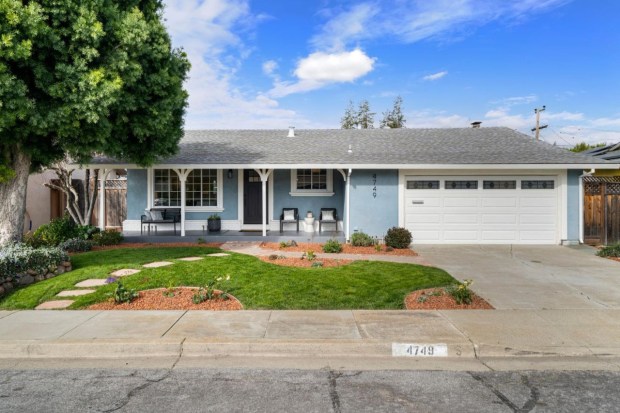
The previous owners of this 1,434-square-foot home, built in 1962, had recently added new flooring and recessed lights, updated bathrooms and upgraded the kitchen with stainless steel appliances. The bedrooms were spacious, and it came with a bonus sunroom not included in the square footage. Unfortunately, because of the sunroom, the living room didn’t get as much light. The home was located a short walk from a nearby elementary school, but far from some of their friends in Santa Clara. It was listed at $1,298,000.
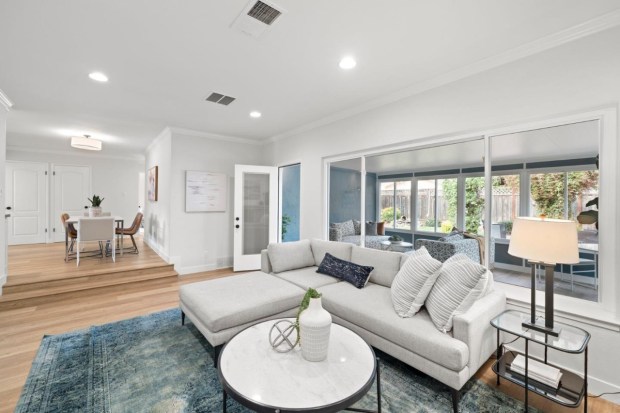
No. 3: Ranch with Lots of Space in South San Jose
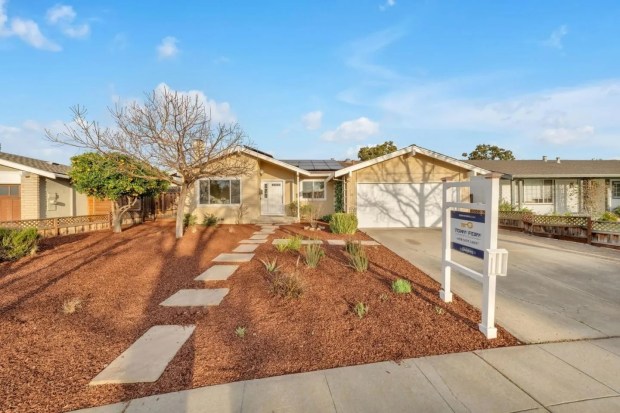
This four-bedroom, two-bathroom home was built in 1968 and came with limestone floors in the kitchen, a large, bright living room, and solar panels already installed on the roof. The home was in a school district that they liked, but at the south end of San Jose, it was far from their community in Santa Clara. The home was the largest option they looked at — 1,755 square feet — and was listed for $1,339,000.

So which one did they choose?
Singh and Dudani made offers on eight different properties before they realized they were getting beat out each time by people overbidding on homes.
“We wanted to be on the low end — but we would bid, and then we didn’t get any responses,” Singh said. “We felt like we were wasting sellers’ time.”
They quickly realized that in Cambrian Park, homes would be listed at $1.5 million and then end up selling for closer to $1.7 million, which was outside of their budget. Such was the case for the split-level they looked at there, which they bid on but lost.
“It was becoming too competitive for us,” Singh said.
Dholakia, their real estate agent, advised them to look at homes around $1.3 million, then bid at $1.5 million.
After the two toured the home in South San Jose, they fell in love and decided to adjust the maximum amount they’d be willing to spend so that they might finally land a place. If that didn’t work, they both agreed to pause their search for a year before they tried again.
But it never came to that. Their bid of $1.625 million won the house.
The Ranch with Lots of Space in South San Jose

Though $1.625 million was more than they’d originally hoped to spend, they scored a win with their mortgage rate. The couple had initially been quoted at a 6.37% rate for a 30-year fixed-rate mortgage, but they found a bank willing to offer 5.75% — a difference of $1,200 a month.
Two weeks ago, the couple moved in, and they are getting used to the joys of home ownership.
“We just saw these weeds start popping up,” Dudani said, pointing at some new growth in the mulch. “We didn’t know what to do about weeds — we’re first-time homeowners!”
They still don’t have enough furniture to fit the space, but they’ll spend the next few months getting the house prepared for their baby girl.

In the meantime, they’re looking forward to using the space to host their friends for parties and gatherings, including a baby shower in June.
Though they’d been concerned about living so far from friends, it turns out that may not be the case.
“Now all our friends are talking about moving out here. We have some friends who will be just 3 miles away,” Singh said. “We’re excited for everyone to be so close by.”
Home prices increased at the fastest clip since 2022 at the start of the year, according to one closely watched home price gauge published Tuesday.
Home prices nationally in January were 6% higher than the same month in 2023, according to S&P CoreLogic Case-Shiller data. Prices in an index measuring changes in 20 of the nation’s large cities increased 6.6%.
Both indexes increased at the quickest annual pace since November 2022.
Seasonally adjusted prices also gained, with the 20-city index rising 0.14% from December, and the national index gaining 0.36%.
“U.S. home prices continued their drive higher,” Brian D. Luke, head of commodities, real and digital assets at S&P Dow Jones Indices, said in a statement. “On a seasonal adjusted basis, home prices have continued to break through previous all-time highs set last year.”
Advertisement – Scroll to Continue
The quick annual gain was expected. The 6.6% gain in the 20-city index was in line with the consensus call among economists surveyed by FactSet. Price gains will continue, but will slow by the end of the year, some economists say.
Prices were higher than year-ago levels in each of the 20 cities tracked by the index. Prices in San Diego, Los Angeles, and Detroit were highest compared to one year prior, rising 11.2%, 8.6%, and 8.2% respectively. The cities with the slowest gains included Dallas, Denver, and Portland, Ore., where prices grew 2.9%, 2.7%, and 0.9%, respectively.
A low supply of homes for sale, combined with a relatively easy comparison with prices at the same time last year, look set to keep prices strong this spring.
Advertisement – Scroll to Continue
The median home in February sold for $384,500, up 5.7% from the same month in 2023, according to the National Association of Realtors. It was the greatest price increase in the trade group’s data set since October 2022.
data suggest prices have remained strong in March. Over the four-week period ended March 17, home-sale prices rose 5.3%.
Industry economists expect gains will slow later this year. The Mortgage Bankers Association estimates that home prices in the fourth quarter measured by the Federal Housing Finance Agency’s home price index will be 4.1% higher than one year prior—a slower growth rate than the anticipated 5.7% in the first quarter of this year.
expects its home price index to be 3.2% higher than one year prior at the end of the year, slower than an anticipated 7.2% first-quarter increase.
Advertisement – Scroll to Continue
That’s despite mortgage rates that remain higher than levels immediately before the pandemic. Higher rates and prices has made it harder for first-time buyers to enter the market. The share of buyers purchasing a previously owned home for the first time fell to 26% of all transactions in February from 28% the month prior, the National Association of Realtors said earlier this month.
The typical buyer in February needed an annual income of $113,520 to afford the median U.S. home, according to a Redfin analysis published Tuesday. That is nearly $30,000 more than the median household income, the brokerage said. The last time the typical household earned more than it needed to afford the median home was three years ago, in February 2021, according to the analysis.
Home values are stretched relative to their historic price-to-rent ratio, Mark Zandi, Moody’s Analytics’ chief economist, wrote in a Monday note. “That valuations have remained so high given the doubling in mortgage rates since just prior to the pandemic is especially surprising,” the economist wrote, adding that high home prices are supported by an undersupply of housing and the mortgage rate lock-in effect.
“For some semblance of normalcy to return to the housing market, something has to give—mortgage rates need to decline, incomes rise, and/or house prices cool considerably,” Zandi wrote. The most likely scenario is that prices move “more-or-less sideways” for one to three years. That would “allow corporate earnings and rents to catch up and valuations to normalize at least partially.”
Write to Shaina Mishkin at shaina.mishkin@dowjones.com
Home prices likely climbed in January, according to one closely watched measure. That trend will continue but gains will narrow by the end of the year, some economists say.
The S&P CoreLogic Case-Shiller Home Price index tracking changes in 20 of the nation’s large cities is expected to have been 6.6% higher in January than it was one year prior, according to FactSet consensus estimates. A seasonally adjusted index measuring month-to-month price gains is estimated to have risen 0.15% from December’s levels. The reading will be released Tuesday at 9 a.m.
A low supply of homes for sale, combined with a relatively easy comparison with prices at the same time last year, look set to keep prices strong. If the estimates are correct, January’s annual home price increase would be the largest since November 2022, according to December’s Case-Shiller data.
The median home in February sold for $384,500, up 5.7% from the same month in 2023, according to the National Association of Realtors—the greatest price increase in the trade group’s data set since October 2022.
data suggests prices have remained strong in March: over the four-week period ended March 17, home sale prices rose 5.3%.
Industry economists expect gains will slow later this year. The Mortgage Bankers Association estimates that home prices in the fourth quarter measured by the FHFA’s home price index will be 4.1% higher than one year prior—a slower growth rate than the anticipated 5.7% in the first quarter of this year.
expects its home price index to be 3.2% higher than one year prior at the end of the year, slower than an anticipated 7.2% first-quarter increase.
Advertisement – Scroll to Continue
That’s despite mortgage rates that remain higher than levels immediately before the pandemic. Higher rates and prices has made it harder for first-time buyers to enter the market. The share of buyers purchasing a previously owned home for the first time fell to 26% of all transactions in February from 28% the month prior, the National Association of Realtors said earlier this month.
Home values are stretched relative to their historic price-to-rent ratio, Mark Zandi, Moody’s Analytics’ chief economist, wrote in a Monday note. “That valuations have remained so high given the doubling in mortgage rates since just prior to the pandemic is especially surprising,” the economist wrote, adding that high home prices are supported by an undersupply of housing and the mortgage rate lock-in effect.
“For some semblance of normalcy to return to the housing market, something has to give—mortgage rates need to decline, incomes rise, and/or house prices cool considerably,” Zandi wrote. The most likely scenario is that prices move “more-or-less sideways” for one to three years. That would “allow corporate earnings and rents to catch up and valuations to normalize at least partially.”
Advertisement – Scroll to Continue
Write to Shaina Mishkin at shaina.mishkin@dowjones.com
The NAR’s multiple listing service, or MLS, used at a local level across areas in the U.S., facilitated the compensation rates for both a buyer’s and seller’s agents.
At the time of listing a property, the home seller negotiated with the listing agent what the compensation would be for a buyer’s agent, which appeared on the MLS. However, if a seller was unaware they could negotiate, they were typically locked into paying the listed brokerage fee.
More from Personal Finance:
When (and if) you’ll get student loan forgiveness
The easiest way for newbies to start investing
FAFSA ‘fiasco’ may result in fewer students going to college
The proposed settlement would have the commission offer completely removed from the NAR’s system and home sellers will no longer be responsible for paying or offering commission for both the buyer and seller agents, said real estate attorney Claudia Cobreiro, the founder of Cobreiro Law in Coral Gables, Florida.
“The rule that has been the subject of litigation requires only that listing brokers communicate an offer of compensation,” the NAR wrote in a press release.
“Commissions remain negotiable, as they have been,” the organization wrote.
However, some of these changes may take time to materialize, experts say.
If a settlement agreement is accepted within a lawsuit between two people, the court generally won’t look at the settlement. Yet, in a federal class-action lawsuit, one that affects a large number of people, there will be a period for the court and interested parties to review the settlement and offer commentary and feedback on the agreement, Cobreiro said.
“That’s the process that we’re about to enter, and that process can take some time,” she said.
As proposed, the settlement would have the NAR completely remove commissions from its MLS system by July. That may be optimistic, Cobriero said.
“It would be more realistic to see this being implemented later this year,” she said.
In the meantime, it’s “business as usual” for buyers and sellers, Cobreiro said. “There is nothing that agents should be doing differently currently in their ongoing transactions.”
A buyer or seller already in the market is probably not going to be affected by the settlement unless their property happens to be on the market a little longer than what’s customary, she said.
“The big gray area here is how will buyer [agent] commissions be handled moving forward,” said Cobreiro, as there is no finalized agreement yet that clearly indicates how that will be handled.
The settlement agreement doesn’t say that the buyer’s agent will not be paid nor that the buyer’s agent cannot charge fees.
“The big question here is who is going to pay for those services moving forward. Will it ultimately be a buyer that will have to get the buyer’s agent’s commission together, on top of closing costs and on top of down payment?” Cobreiro said.
While commission fees are negotiable between involved parties, knowing what cards you have on the table as a homebuyer will be more important now than before. Using an agent will still be a smart way to achieve that, experts say.
“A great local agent can give you a competitive advantage,” said Amanda Pendleton, a home trends expert at Zillow Group. That’s especially true as low-priced starter homes are expected to remain in demand, she said.
Here are two things to know about how the settlement could change the process of buying a home:
1. Buyers could be responsible for their agent fees: Historically, real estate commissions typically come out of the seller’s pocket, and are split between the buyer’s and seller’s agents.
As a result of the settlement, the seller will no longer be responsible for commission fees for a buyer’s agent. So this is a new potential charge buyers need to consider in their budget. Historically, if a buyer’s agent got half of a 5% or 6% commission, that equaled thousands of dollars.
For example: The median home sale price by the end of 2023 was $417,700, according to the Federal Reserve. That would mean commissions at a 5.37% rate — the 2023 average rate, according to Lending Tree — amount to roughly $22,430, about $11,215 of which might go to the buyer’s agent.
But bypassing an agent’s services may not lead to direct savings, especially for first-time buyers, experts say. You could put yourself at risk by leaving the homebuying process entirely to the seller and their agent, said Cobreiro.
Sometimes things show up in your home inspection report that merit a credit from the seller, but if you don’t have an agent, the seller’s agent may not volunteer that, said Cobreiro.
Doing so would be a breach of their fiduciary duty to the seller, and it affects their commission if the price of the property declines, she said.
“Signing the contract is the least of it; there’s so many things that happen throughout the transaction that really require the expertise and the navigation by someone who understands the process,” she said.
2. Buyers may be required to sign a contract early on: If buyers become responsible for their agent’s commission, you’re likely to see more agents asking buyers to sign a buyer-broker agreement upfront, before the agent starts helping them find a property.
Most brokerages have a buyer agency agreement, but it’s common for real estate agents to wait to present the contract.
“They want to win the person’s business, they don’t want to scare them with having to sign any contracts,” said Steven Nicastro, a former real estate agent who writes for Clever Real Estate.
Moving the contract talks to earlier in the process is a precaution to protect buyer’s agents in the market.
“That could lead to negotiations actually taking place at the first meeting between a buyer and the buyer’s agent,” Nicastro said.
Know you can negotiate the commission rate as well as the duration of the contract, which can span from three months to a year, Cobreiro said.
“The effect [of the move] is more business to our frontline workers in the real estate agency industry as a whole,” Sui said in a television interview. “We absolutely welcome this.”
The cooling measures were scrapped with immediate effect on February 28, ending the imposition of a buyer’s stamp duty designed to target non-permanent residents, a stamp duty for second-time purchasers and a special stamp duty aimed at homeowners who resold their property within two years.
Former chief executive Leung Chung-ying first imposed the curbs to rein in property speculation and reduce external demand.
Property agency giant Midland Realty said the number of transactions at the city’s 35 largest housing estates hit three figures for two consecutive weeks after the measures were lifted, the highest level in nearly two years.
The transaction volume was more than 1.5 times higher than last year’s average of 54 cases per week, the agency said.
“The trading performance of new properties has been brilliant and the trading volume of secondhand ones has further improved,” a Midland spokesman said last Monday.
The number of transactions at South Horizons in Ap Lei Chau and Tai Po Centre in the New Territories both increased by 400 per cent, respectively, securing 10 and five deals between March 4 and 10, up from just two and one the previous week, Midland said.
HKMA asks banks to exercise caution when lending for ‘confirmor sales’
HKMA asks banks to exercise caution when lending for ‘confirmor sales’
Uptown East in Kowloon Bay, a new project, sold its first round of 336 flats on Sunday after it received 6,899 registrations, an oversubscription of more than 19.5 times.
Siu warned the average number of complaints might increase with the surge in deals and advised prospective homebuyers to consult banks before they made any decisions.
Buyers should pay attention to potentially illegal advertisements that provided misleading information by methods such as mixing up the saleable area – the actual size of a home – and the gross area, which includes common areas such as lobbies, partitions, mechanical shafts and ducts.
“[Property agents] should never tell buyers how much the lenders can offer for the mortgage,” Siu said. “Some banks don’t provide mortgages for properties such as village houses.”
He also told homebuyers to find out whether a house might not be eligible for a mortgage because of a past death at the property.
“There is no complete definition of a haunted house,” Siu said. “The most proper way is to ask a bank first about whether someone died there or jumped to their deaths there.”
The authority issued a circular last December on the sale of incomplete properties in mainland China and overseas, requiring real estate agents to engage a lawyer based in those jurisdictions to provide legal advice covering due diligence and key information on the seller and the property project.
The new measure will take effect on July 1 and agents who violate the rule may be subject to disciplinary action, with penalties ranging from a reprimand and fine to having their licence revoked.
Hong Kong to take more cautious approach to land sales, development chief says
Hong Kong to take more cautious approach to land sales, development chief says
As the mainland’s property market has lurched from crisis to crisis, with some major developers mired in debt, it has become increasingly common for construction projects to be left unfinished.
Advertisements for properties in places such as Britain, Australia and Japan are also often found in the city.
Siu said that the new arrangement ensured buyers could seek legal recourse through a local lawyer if they encountered misleading information from a seller.
He also reminded homebuyers that some places might not protect buyers of yet-to-be completed property as well as Hong Kong did. He suggested they contact a licensed agent in the city to help handle the purchase.
Authorities implemented a tenancy control mechanism dedicated to subdivided flats in 2022 to offer four-year security of tenure for the tenants and restrict the rate of rent increase on tenancy renewal to no more than 10 per cent.
Siu said the authority had fielded 13 complaints about real estate agents’ breach of the control regulations, of which four were under investigation, by the end of 2023.
The remaining nine cases could not be continued because of insufficient information, he added.
Sui also warned real estate agents to ensure they complied with the control mechanism as infractions could attract punishments ranging from a fine to licence revocation.
“The effect [of the move] is more business to our frontline workers in the real estate agency industry as a whole,” Sui said. “We absolutely welcome this.”
The cooling measures were scrapped with immediate effect on February 28, ending the imposition of a buyer’s stamp duty designed to target non-permanent residents, a stamp duty for second-time purchasers and a special stamp duty aimed at homeowners who resold their property within two years.
Leung Chun-ying imposed the curbs to rein in property speculation and reduce external demand when he was chief executive from 2012 to 2017.
Property agency giant Midland Realty said the number of transactions at the city’s 35 largest housing estates hit three figures for two consecutive weeks after the measures were lifted, the highest level in nearly two years.
The transaction volume was more than 1.5 times higher than last year’s average of 54 cases per week, the agency said.
“The trading performance of new properties has been brilliant and the trading volume of second-hand ones has further improved,” a Midland spokesman said last Monday.
The number of transactions at South Horizons in Ap Lei Chau and Tai Po Centre in the New Territories both increased by 400 per cent, respectively, securing 10 and five deals between March 4 and 10, up from just two and one the previous week, Midland said.
Uptown East in Kowloon Bay, a new project, sold its first round of 336 flats on Sunday after it received 6,899 registrations, an oversubscription of more than 19.5 times.
James Cheung King-tat, the executive director of Centaline Surveyors, a subsidiary of another estate agency giant Centaline Property Agency, said home prices did not record a surge in line with the transaction volume because home sellers had taken a conservative view of the city’s economic prospects.
HKMA asks banks to exercise caution when lending for ‘confirmor sales’
HKMA asks banks to exercise caution when lending for ‘confirmor sales’
“Even the price increase for first-hand properties has remained small as developers scramble to sell off their unsold units,” he added.
But Cheung said he expected the property market to warm up further with other “feelgood factors” predicted for later in the year giving a boost to the market.
“We expect the interest rates to decrease in the second half of this year, lessening the mortgage holders’ burden,” he said.
The Real Estate Developers Association of Hong Kong earlier estimated home prices to rebound by 5 to 7 per cent this year.
“Although the world’s economy isn’t doing great, it’s begun to gain the momentum to recover slowly,” association chairman Stewart Leung Chi-kin said last week.
Siu also warned the average number of complaints might increase with the surge in deals and advised prospective homebuyers to consult banks before they made any decisions.
Buyers should pay attention to potentially illegal advertisements that provided misleading information by methods such as mixing up the saleable area – the actual size of a home – and the gross area, which includes common areas such as lobbies, partitions, mechanical shafts and ducts.
“[Property agents] should never tell buyers how much the lenders can offer for the mortgage,” Siu said. “Some banks don’t provide mortgages for properties such as village houses.”
He also told homebuyers to find out whether a house might not be eligible for a mortgage because of a past death at the property.
“There is no complete definition of a haunted house,” Siu said. “The most proper way is to ask a bank first about whether someone died there or jumped to their deaths there.”
Hong Kong to take more cautious approach to land sales, development chief says
Hong Kong to take more cautious approach to land sales, development chief says
The authority issued a circular last December on the sale of incomplete properties in mainland China and overseas, requiring real property agents to engage a lawyer based in those jurisdictions to provide legal advice covering due diligence and key information on the seller and the property project.
The new measure will take effect on July 1 and agents who violate the rule may be subject to disciplinary action, with penalties ranging from a reprimand and fine to having their licence revoked.
As the mainland’s property market has lurched from crisis to crisis, with some major developers mired in debt, it has become increasingly common for construction projects to be left unfinished.
Advertisements for properties in places such as Britain, Australia and Japan are also often found in the city.
Siu said that the new arrangement ensured buyers could seek legal recourse through a local lawyer if they encountered misleading information from a seller.
He also reminded homebuyers that some places might not protect buyers of yet-to-be completed property as well as Hong Kong did. He suggested they contact a licensed agent in the city to help handle the purchase.
Authorities implemented a tenancy control mechanism dedicated to subdivided flats in 2022 to offer four-year security of tenure for the tenants and restrict the rate of rent increase on tenancy renewal to no more than 10 per cent.
Siu said the authority had fielded 13 complaints about real property agents’ breach of the control regulations, of which four were under investigation, by the end of 2023.
The remaining nine cases could not be continued because of insufficient information, he added.
Sui also warned real property agents to ensure they complied with the control mechanism as infractions could attract punishments ranging from a fine to licence revocation.
Story continues below Advertisement
The boom in Mumbai realty was over in early 2023, which I pointed out in my February 2023 column, The slowdown in Mumbai real estate is here. Thereafter, sales have just chugged along at a modest pace, of about 10,000 registrations per month on average. Expectations were high in the festive season of October – December 2023, but that turned out to be a disappointment. Why?
There are multiple factors at play. The pent-up demand for homes got soaked up between August 2020 to December 2022, and was followed by a 5X jump in the number of launches in many micro-markets. In a trust-deficit market like Mumbai, selling under-construction projects is a challenge, but the matter has been compounded with excessive competition and inflated prices. That’s resulted in slow sales for an industry which largely depends on customer advances for funding almost 40-50 percent of the project cost.
Story continues below Advertisement
What next?
1) Branded players in under-supplied markets will succeed: harsh as it may sound, the average Mumbai home buyer has terribly low expectations. He wants a lot, but knows that expecting anything more than smooth delivery of his home is unrealistic in most cases. Branded players offer him the hope that all his dreams will be fulfilled, on time. Hence, branded players in under-served markets will thrive even at elevated prices. Example: Godrej’s project in Raj Kapoor’s bungalow plot in peaceful Chembur, Rustomjee’s sea-facing project at Bandstand (Bandra), etc.
In micro-markets that are competitive, branded players will need to price attractively to garner sales. On the other hand, developers without a credible record and history will struggle to sell their under-construction units even at lower prices.
Story continues below Advertisement
2) Luxury market to tumble: ‘luxury’ is an abused term in the real estate business. And at no other time has it been abused to the degree as it is today. Yet — even with the assumption that a luxury project means one with a ticket size of at least Rs 8 crore, or about a million dollars — there are too many options from too many first-timers catering to too few buyers.
Besides, the ticket size alone doesn’t define ‘luxury.’ That needs a combination of home size, plot size, design, amenities, finishing, etc., — a mix that remains elusive for a majority of players. Property consultant Vivek Bathija points out that, “Over 50 percent of projects are not luxury, but pseudo-luxury projects, which have priced themselves out of the market. Price cuts of 20 percent are needed for them to attract buyers.”
3) Payment plans to become popular: we are at the beginning of the payment plans cycle. It’s common to see schemes of “Pay 20 / 30 percent now, and the rest on possession.” The schemes are designed to ensure that skin in the game for the buyer is limited if the project stalls. Chintan Vasani of Wisebiz Developers says, “Builders who do not price it right or give the right payment plan are struggling, and they will continue to struggle as more projects get launched.”
Story continues below Advertisement
4) Slow project acquisition: it will be an understatement to say that project acquisition by builders has been hot in recent months. Developers have gone all-in making generous offers for land acquisition, especially in the redevelopment market. Small and mid-size players are treating the current cycle as their opportunity to jump into a higher orbit. There are many builders who are doing more projects today than they have done in their entire career. With the market slowing down, project acquisition will moderate, although I suspect that land prices will not.
5) Aggregate volumes to remain steady: supply creates its own demand, hence, home sales at an aggregate level will remain steady (reflected in the registration numbers), although the demand will be spread over a larger number of projects.
As for a price correction, I anticipate a large section of builders will be in denial initially, but eventually bite the bullet.
Discover the latest business news, Sensex, and Nifty updates. Obtain Personal Finance insights, tax queries, and expert opinions on Moneycontrol or download the Moneycontrol App to stay updated!

